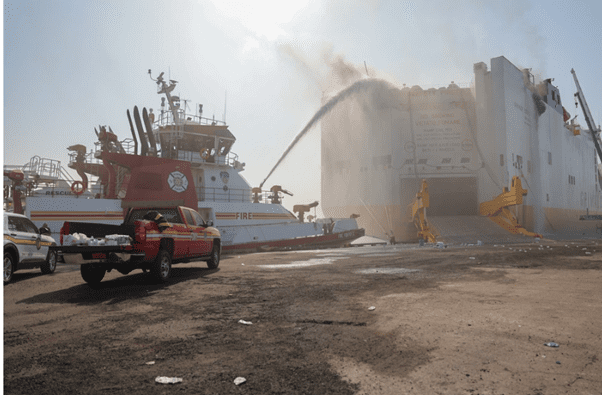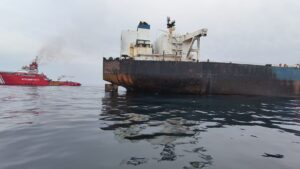
A formal public hearing in January to consider evidence related to the deadly fire that occurred aboard the Italian-flagged cargo vessel Grande Costa D’Avorio while docked at the port of Newark, New Jersey, with the loss of two firefighters this past July, will be conducted by the US coast guard, in conjunction with the national transportation safety board.
According to the Coast Guard, the hearing which will be conducted in the greater Newark area, will focus on the condition of the Grande Costa D’Avorio prior to and at the time of the fire, the cargo loading process for vehicles at the port of Newark, initial response actions by the ship’s crew, and response to the fire by local land-based fire departments.
The fire aboard the Grande Costa D’Avorio occurred at the port of Newark during cargo loading operations July 5, 2023.
Two Newark firefighters died as they were trying to put out a fire that broke aboard the cargo vessel in port Newark, New York.
There have been two fatalities and six injuries sustained due to responding to the fire aboard the vessel.
The formal hearing, which will be open to the public, as well as broadcast live and recorded, to ensure public access and participation with the proceedings, is scheduled to convene the week of January 8 and continue through the week of January 15.
The exact dates and times will be shared closer to the scheduled hearing date.
The Grande Costa D’Avorio marine casualty met the requirements for a formal investigation level of effort due to the loss of two Newark firefighters’ lives during the response, and the significant damage to the Grande Costa D’Avorio, as the US coast guard reports.
This was influenced primarily by the potential lessons to be derived from the casualty for public interest.
A formal investigation is composed of a specially designated lead investigating officer to serve as the presiding officer. Rear Adm. Mauger also designated several specialists and technical experts to assist the lead investigating officer.
The coast guard is jointly conducting the investigation with the National Transportation Safety Board, with participation by the Italian General Directorate for Railway and Maritime Investigations (DiGlFeMa).


